Pink lilies: description of varieties and tips for growing them

One of the most graceful flowers are lilies, and if they have a pink bud, the bouquet will be doubly romantic. Many gardeners dream of growing such flowers on their plots, however, not everyone knows about the nuances of caring for such flowers, as well as about the features of pink lily varieties. All these and other intricacies of placing similar flowers on your site will be described in detail in this article.
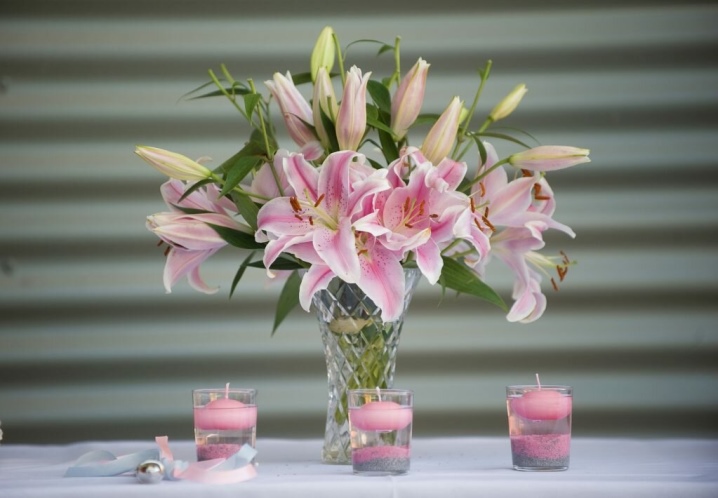
Review of the best varieties
These flowers come in many different varieties, each with its own unique description. The most popular varieties of pink lilies are as follows.
- "Lollipop" - flowers from 90 to 100 cm high, which combine bright pink and white colors in their buds. Pink is found around the edges of the bud. Inflorescences include 3 to 5 flowers. Moreover, this variety is characterized by a rather large bulb size.
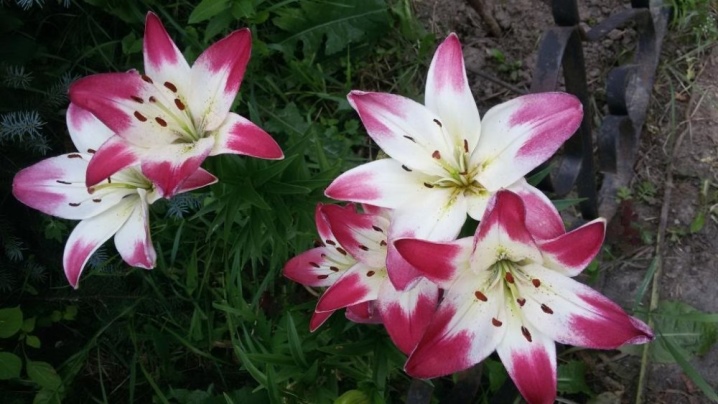
- Stunning pink color characteristic of the variety "Magic Star", which is shaped like a star. In addition to pink, there is a crimson hue in the bud of such a lily, passing in the form of a spot along the petal. In diameter, these densely doubled flora representatives reach 20 cm, and their height is 100 cm.

- Lilies have the same parameters. varieties "Marlene"... They are pale pink in color, and their long leaves are slightly pointed. In the center of the flower, a red speck is slightly pronounced.
It is noteworthy that the number of buds on the stem of one plant can reach 100 pieces.
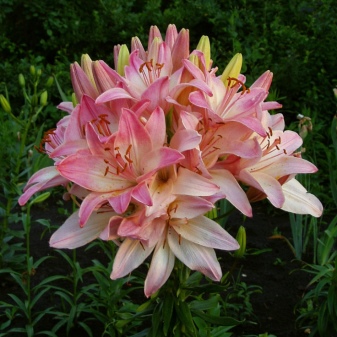
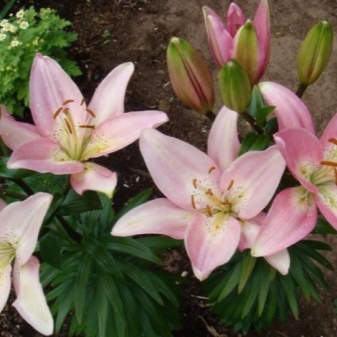
- The tall variety is American lily "Lake Tular", which grows up to 120 cm. At the same time, the petals of its pink buds, in the central part of which there are red dots, are bent back. Due to this, the plant looks rather unusual for this type of flowers.
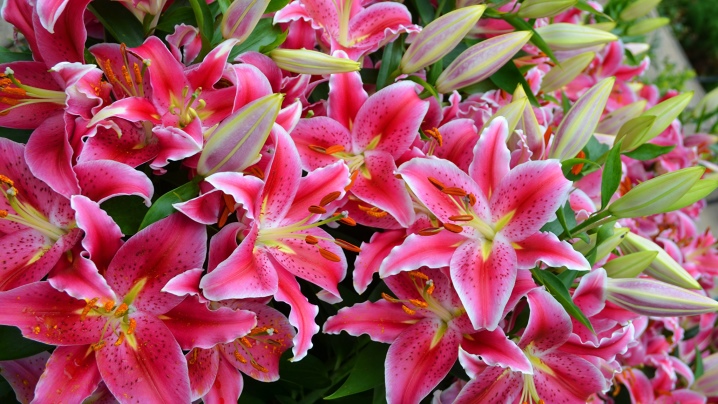
- The real giant among lilies is grade "Salmon star", the buds of which are painted in a delicate salmon shade. A plant 200 cm high blooms in the first half of summer with very large flowers.
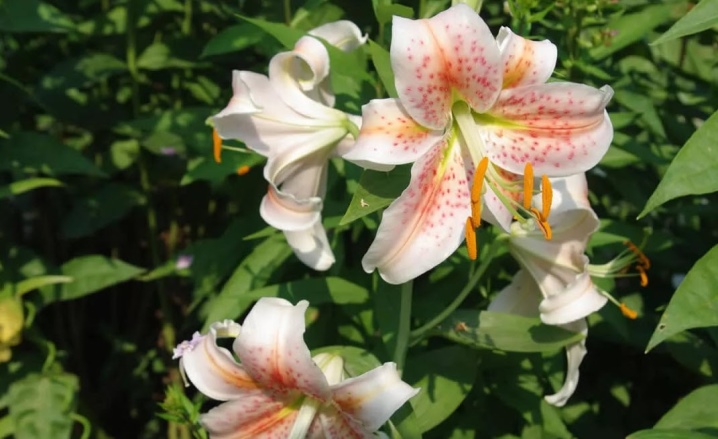
- "Stargazer" - lily of the oriental type with strongly curved petals of a rich pink tone. At the same time, dark red spots are visible against the bright background of the petals. The height of such plants reaches from 80 to 100 cm, and the diameter of the bud is 17 cm.
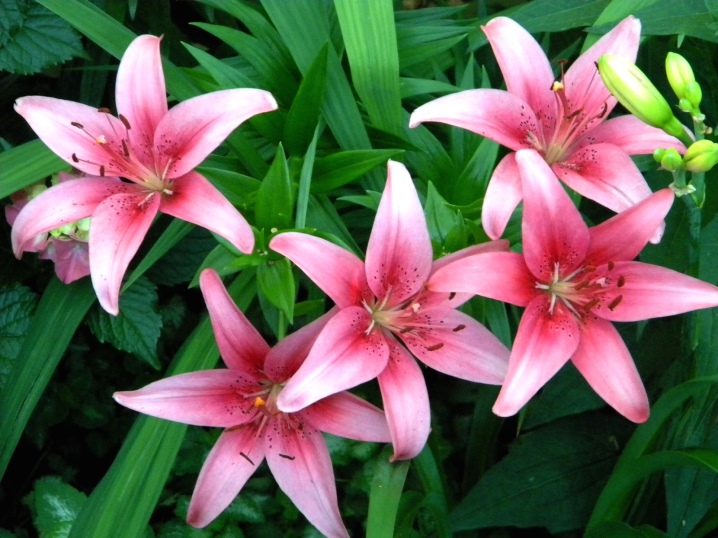
- Saturated in color is also grade "Canberra"that blooms in late summer. The bush of such a lily is up to 180 cm in height, the buds are in the shape of a star, and their rich crimson color is diluted with a yellow spot in the middle, as well as small red spots scattered over the petals.
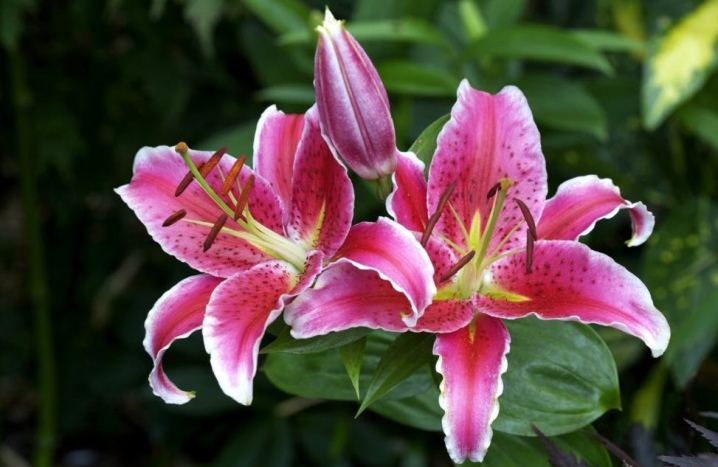
- Also tubular varieties are painted pink, such as "Pink Perfection"... On a bush up to 180 cm high, there are from 5 to 7 flowers of a dark pink hue. In this case, the pistil and filaments of the stamens are bright orange in color. The tubular buds are up to 13 cm long and 11 cm in diameter.
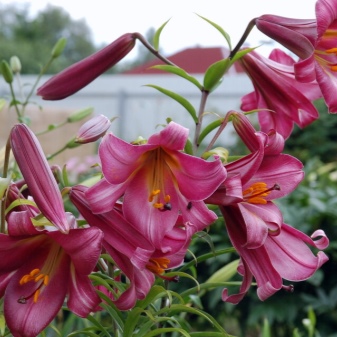
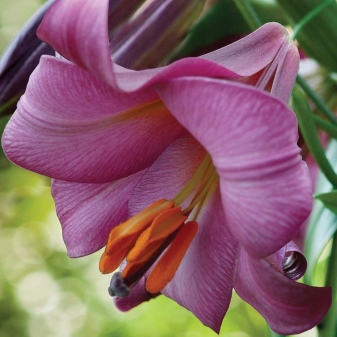
- Variety "Scheherazade" has large pink buds, the petals of which are outlined with a white border and contain a slight dark speck.
This Dutch variety is presented in the form of a fairly tall bush, needs protection from wind and warm temperatures.
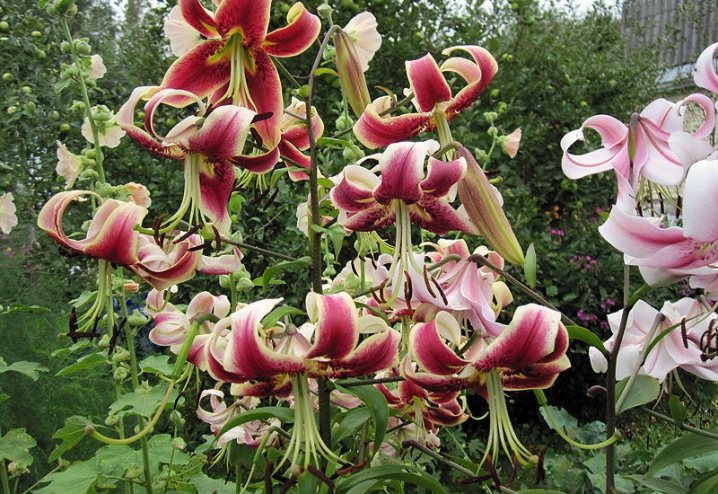
- Lily "Baywatch" belongs to OT-hybrids, has large light pink flowers reaching a diameter of 25 cm. The height of the bush is from 100 to 120 cm. In this case, the buds are cup-shaped and have a lemon-colored core. These lilies are famous for their magnificent scent.
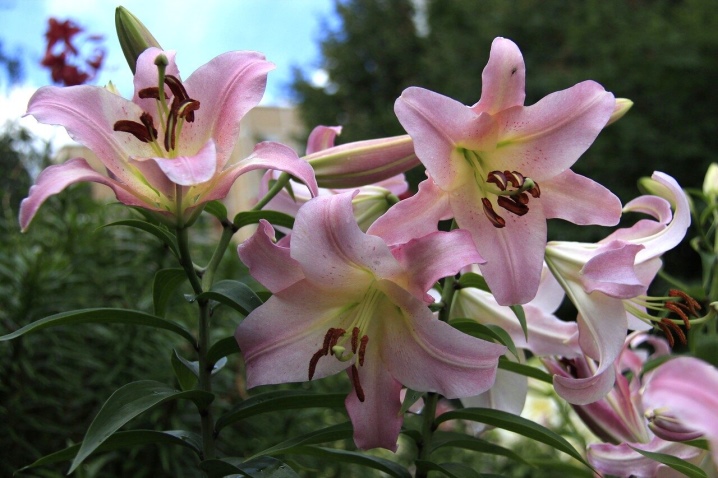
- Variety "Rosells Dream" differs in that in the central part of the petals the color of the bud is creamy, and then it smoothly turns into bright pink ends. There is also a brown speck on the flowers.

- "Distance Drum" - dark pink lilies with white edging of petals. A feature of these plants is the absence of staining anthers. The aroma of the representatives of this variety is very light and unobtrusive.
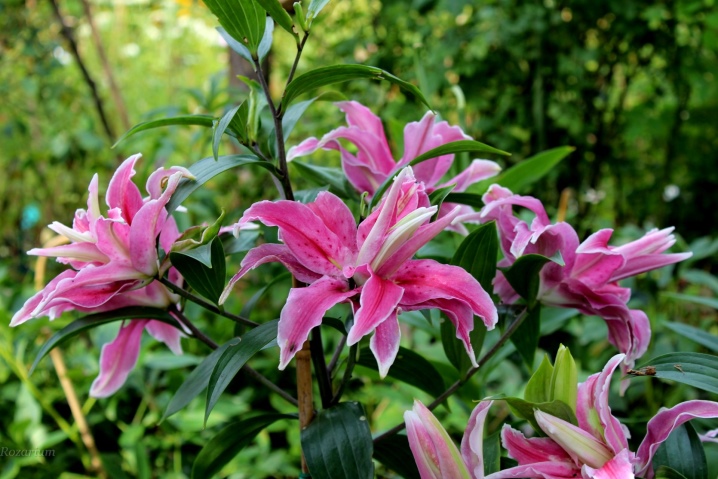
- Lily "Belonica" perfectly combines 3 colors. Soft pink occupies most of the petal, at the edges it turns into white, and contrasting crimson is presented in the form of stripes on the petals. These flowers also lack anthers.
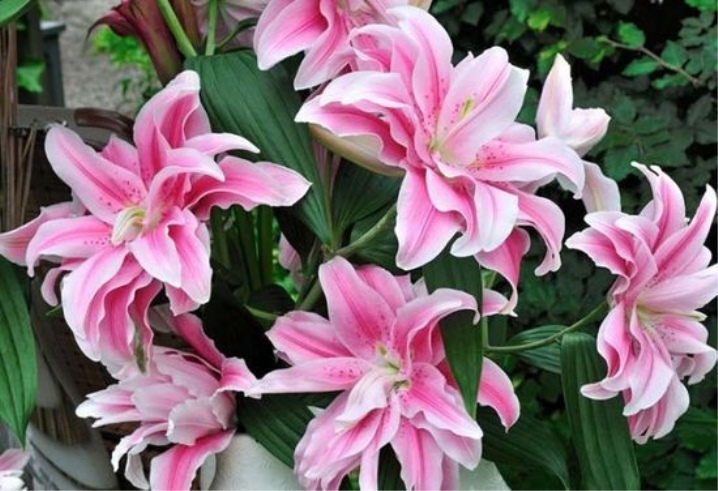
- Variety "Pink Brush" is a bush 120 cm high. The diameter of the spreading flower is 18 cm, and its warm pink shade is diluted with abundant burgundy dusting.

- Bellsong tubular flowers have a single-color pale pink color and exude a light aroma. The bush grows up to 110 cm and blooms in the middle of summer. The shape of the buds of such lilies is often compared to the shape of bells.
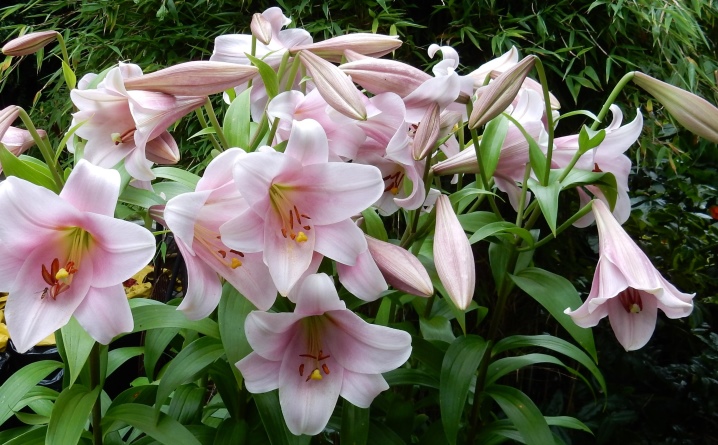
- Hybrid variety "Pink Palace" characterized by very large flowers up to 22 cm in diameter. In this case, the petals of the bud are, as it were, bent down. In height, these plants can reach up to 1.5 m.
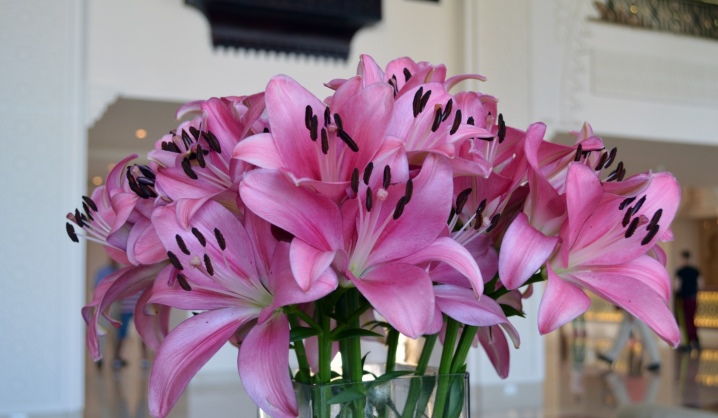
- Small light pink flowers with a diameter of 12 cm are characteristic of Spring pink varieties... Their edges are not so clear, and the delicate tone of the petals is diluted with specks and a narrow border at the base, painted in a purple tone. One inflorescence contains 14 flowers, the petals of which are directed upwards.
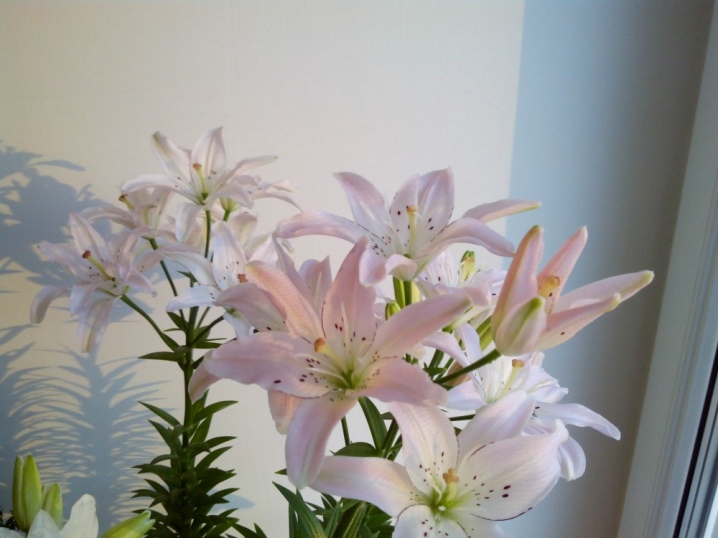
- Tubular lilies "Pink planets" up to 90 cm high they have a pleasant candy-pink shade of the bud and petals curved outward.
Moreover, their flowers are facing upward, which is not typical for tubular forms.

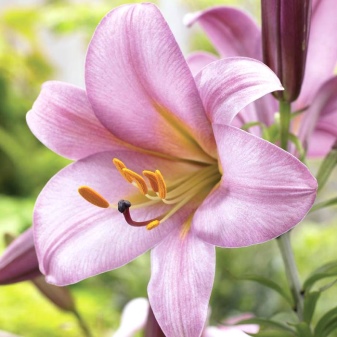
- Bushes variety "Pink Giant" height from 90 to 150 cm, bloom with peach-pink buds with dark specks. One inflorescence can have from 12 to 20 flowers, which bloom in mid-June.

- Large variety of lilies "Pink Haven" rich pink buds with a diameter of 20 cm are inherent. Moreover, in the central part of the flower, the pink color is even more intense than at the edges. 2 or 4 flowers are usually collected in pyramidal inflorescences.
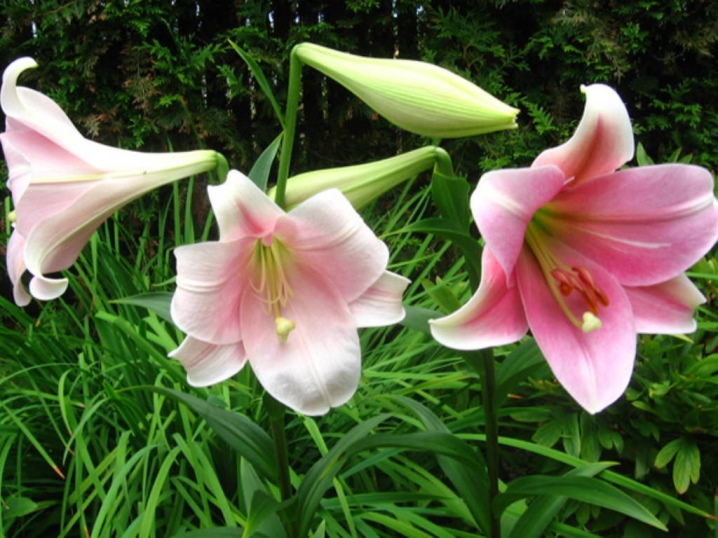
- Lily bush "Pink diamond" reaches 120 cm in height. The flowers are bright pink and have a white border around the edges. There is a vertical dark pink stripe in the center of each petal.
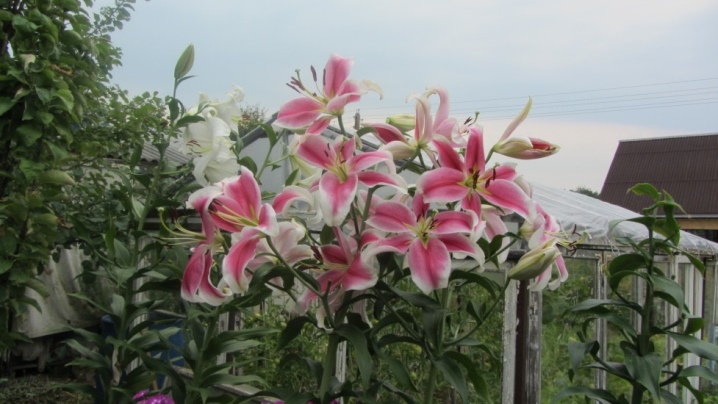
- Plants look really exotic varieties "Pink parrot cariba", since in the open form of the bud, the uneven edges of its elongated petals are clearly visible. This lily blooms from mid to late summer. And in height the bush reaches from 90 to 120 cm, while over time it can become taller.

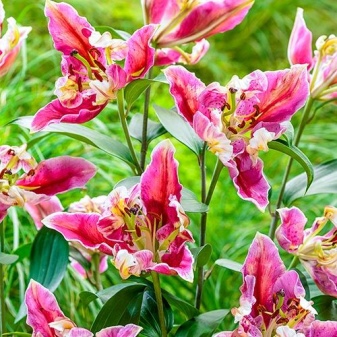
- Lily "Pink Mist" Is a graceful hybrid with cold pink flowers, the petals of which form a beautiful outward curve. The core of the flower is white, and its diameter reaches 23 cm.The height of the bush is 105 cm.
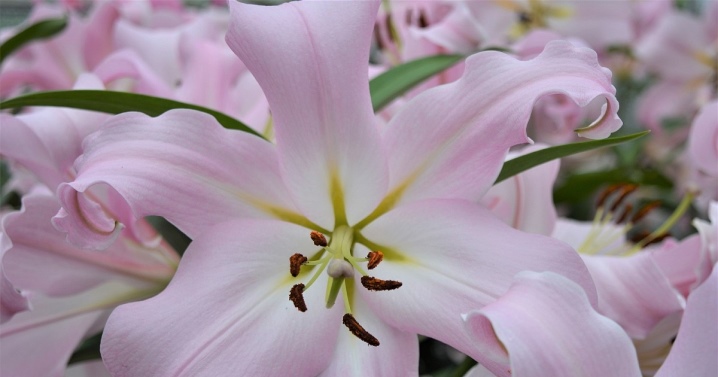
- Tiger pink lily "Pink flavor" has a warm color of the bud with pale yellow spots in the center of each petal and numerous dark blotches. This flower can be grown not only in the garden, but also in a pot in an apartment.
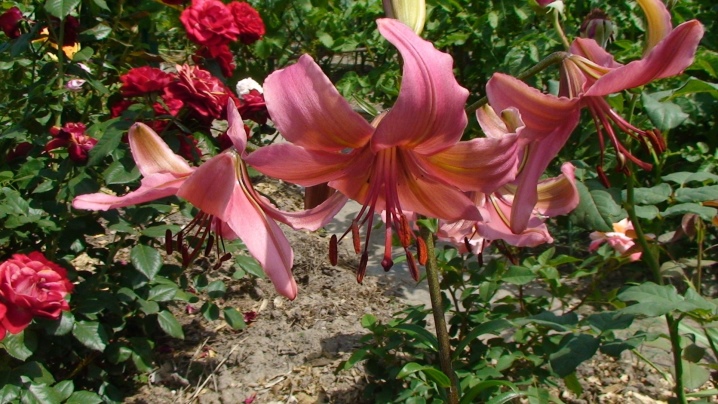
- For Morpho pink lilies characterized by a warm color of the petals, more saturated towards the center, as well as the presence of burgundy specks. The diameter of one flower is 15 cm, and in the inflorescence they are collected in several pieces at the very top of the stem.
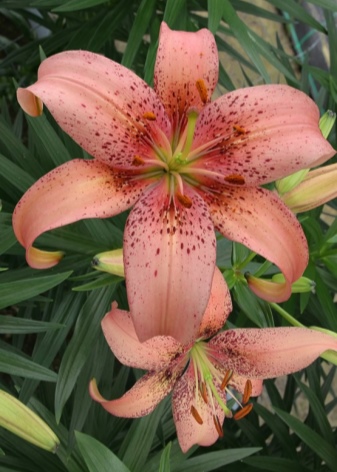
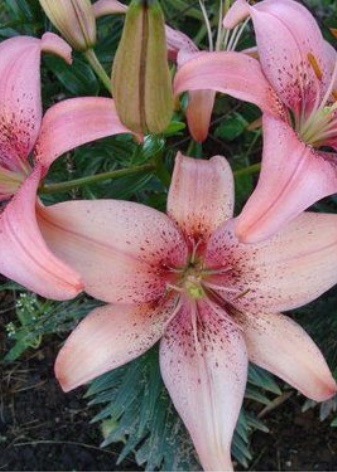
General rules for growing
In order for the varieties of pink lilies to be comfortable on your site, you should take care of its proper cultivation and planting. It is necessary to take into account the following nuances for the successful adaptation of this flower.
- These representatives of the fauna should be located in an open area, but at the same time it should be not heavily blown by the wind and slightly shaded. However, placing a flower bush near a tree is not the best option.
- As the most favorable soil for such a plant, it is worth choosing light loam, as well as loose sandy loam, fertilized with nutrients.
- The preparation of the soil for the plant is carried out in advance. Elements such as peat, sand, organic fertilizers, and humus are added to heavy soil. The amount of fertilizer should not be more than necessary, otherwise the bush will actively grow. Remember that you cannot transplant a flower earlier than after the first 3 years of its life.
- The best time to plant a plant is autumn. However, a pink lily is also planted in the spring, after making sure that the soil has completely thawed.
- You can calculate the planting depth of a flower by multiplying the parameter of its bulb by 3, and also taking into account the lightness of the soil. The lighter it is, the deeper the bulb is placed. Indicators for pink lilies are a depth of 10 cm in the case of undersized varieties, for medium-sized plants, the optimal depth is 15 cm, and for tall bushes, the bulb is placed 20 cm in the soil. Also remember about the distance between plants, which for large varieties should be 25 cm, and for short ones - 15 cm.
- The main procedures for the successful growth of a lily are weeding and loosening of the soil.
- Plant feeding should be done only if fertilizers were applied during soil preparation.
- It is necessary to maintain a moderate soil moisture, carrying out timely watering. However, you should not allow waterlogging, since lilies do not like it. The most favorable time for watering is in the evening, and you need to pour water at the root, avoiding it getting on the leaves of the plants.
- To better retain moisture around the flowers, a procedure such as mulching the soil should be carried out.
- Lily should be propagated in a timely manner. This is best done by dividing the bulbs that form after the first 3 years. If you do not remove the new part of the bulb, then the buds of the plant will be smaller, so reproduction is rather a necessary process.
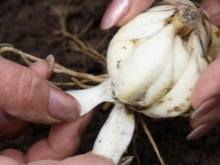
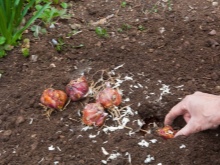

Diseases and pests
Like any garden plant, pink lilies are susceptible to a number of diseases that can affect different parts of the bush. The most common diseases of lilies include the following.
- Botrytis, also called gray mold, is a fungus that starts in the leaves. At first, the disease manifests itself in the form of brown spots on the foliage, and later it turns into mucous formations with a gray bloom and spreads to all parts of the flower. Treatment is carried out with a fungicidal solution.
- Lily leaves are also susceptible to cercosporosis, which manifests itself in the form of spots. A feature of the disease is its rapid spread. Therefore, it is necessary to carry out the treatment of the bush in a timely manner with Bordeaux liquid 1%.
- Penicellosis is a dangerous disease that leads to decay of lily bushes. A diseased plant can be distinguished by its slow growth rate, as well as weak peduncles. Later, a greenish bloom begins to form on the stems, buds and foliage. To prevent disease, lily bulbs need to be treated with a manganese solution.
- A blow to the bulb of a plant is inflicted by fusarium. The complexity of this ailment is that it cannot be recognized by the appearance of the plant, however, if the disease is not treated, the lily is unlikely to be able to survive the winter. You can prevent the process of infection by treating the soil with a solution of copper sulfate, which has disinfecting properties.
- Lily rhizomes can suffer from phytium, which is also a fungal formation. The defeat occurs slowly and manifests itself in the form of a weakening of flowering processes and a deterioration in decorative qualities. The end result is yellowing and drying of the flowers.To get rid of the disease, the affected parts must be cut off, and the flower itself must be transplanted into the soil, which has been pre-treated with 4% colloidal sulfur.
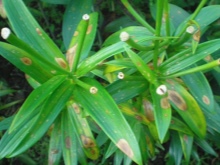


Do not forget about insect pests, among which the most dangerous for pink lilies are the lily fly and the lily beetle. These parasites eat the flowers and leaves of lilies, thereby depriving them of their beauty and damaging the state of plants. You can get rid of pests by collecting their larvae by hand, or you can use special insecticides such as Thunder, Flycatcher and Grizzly. However, these substances can leave dark spots on the buds.
Examples in landscape design
Pink lilies are very beautiful elements of any garden, so they are often used in landscape design, creating interesting compositions on the site. Take a look at the following examples of these options.
- Flowers can be arranged in a row near a stone path. In doing so, they are also complemented by lower plants, framing the garden path.
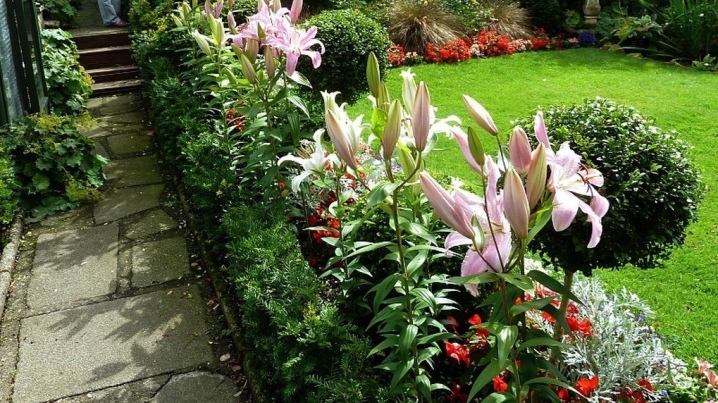
- Pink lilies can also be placed in clusters behind lower plants.

- Garden lilies blend wonderfully with sprawling greenery, which is gracefully bounded by stones.

Tips for growing lilies from an experienced gardener in the video below.







































































































The comment was sent successfully.